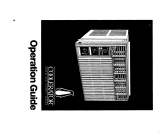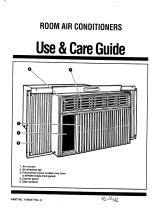
If you need service or
assistance, we suggest you
follow these four steps:
1. Before calling for assistance
Performance problems often result from little things
you can find and fix yourself without tools of any
kind.
Unit won’t run:
1. Is unit plugged in?
2. Is switch ON?
3. Is thermostat set too WARM?
4. Is time-delay fuse blown?
5. Has local power failed?
Unit blows fuses:
1. Are time-delay fuses used?
2. Is an extension cord being used? (Do not use.)
3. Are you waiting two minutes after turning cooling
circuit off before trying to restart unit?
Unit turns on and off, or does not cool room:
1. Is filter clean?
2. Are coils clean? Both evaporator (inside) and con-
denser (outside)?
3. Is there excessive moisture or heat? (Open vessel cooking,
showers, etc.)
4. Set fan to higher speed.
5. Set thermostat to a cooler setting.
Operating sounds:
1. When your room air conditioner is operating normally,
you will hear sounds such as:
l
Droplets of water hitting the condenser, causing a
“pinging” or “clicking” sound. Water droplets help
to cool the condenser.
l
Air movement from the fan, especially on high fan
speed setting.
l
Clicks from thermostat cycle.
2. Sounds also may be caused by house construction -
such as vibration of the unit due to wall construction
or unsteady window mounting area.
2. If you need assistance
Call the Whirlpool COOL-LINE@ service assistance
tF’ephone number. Dial free from:
Continental U.S. . , . . . . . . . (800) 253-1301
Michigan . . . . . . . . . . . . . . . (800) 632-2243
Alaska & Hawaii . . . . . . . . . (800) 253-l 121
and talk with one of our trained Consultants. The
Consultant can instruct you in how to obtain sat-
isfactory operation from your appliance or, if ser-
vice is necessary, recommend a qualified service
company in your area.
3. If you need service
Whirlpool has a nation-
wide net work of fran-
chaised TECH-CARE@
service
Companies.
TECH-CARE service
technicians are trained
to fulfill the product
warranty and provide
after-warranty service,
anywhere in the United States. To locate TECH-
CARE service in your area, call our COOL-LINE
service assistance telephone number (see Step 2) or
look in your telephone directory Yellow Pages
under:
APPLIANCES-WOUSEHOLD- ELECTRICAL APPLIANCES-
MAJOR-SERVICE 6 REPAIR
MAJOR--REPAIRING h PARTS
WHIRLPOOL APPLIANCES
FRANCHISEDTECH-CARE SERVICE Ofl
WHIRLPOOL APPLIANCES
FRANCHISED TECH-CARE SERVICE
SERVICE COMPASIES
SER I’ICE C0MPAaYIE.S
XYLSERVICE CO XYZ SERVICE CO
123 Maple
4. If you
999.9999 123 Maple
999~9999
OR
WASHING MACHINES. DRVERS
h IRONERS-SERVICING
WHIRLPOOL APPLIANCES
FRANCHISEDTECH~CARE SERVICE
SERVICE COMPA.I’IES
XYZSERVICECO
123 Maple
999.9999
have a problem
Call our COOL-LINE service assistance telephone
number (see Step 2) and talk with one of our
Consultants, or if you prefer, write to:
Mr. Robert Stanley
Division Vice President
Whirlpool Corporation
2000 US-33 North
Benton Harbor, Ml 49022
If you must call or write, please provide: model
number, serial number, date of purchase, and a
complete description of the problem. This informa-
tion is needed in order to better respond to your
request for assistance.
0
FSP is a registered trademark
of Whirlpool Corporation for
FSP
quality parts. Look fof this
symbol of quality whenever
8 you need a replacement part
for your Whirlpool appliance
FSP replacement parts
will fit right and work right because they are
made
to the same exacting specifications
used lo build every new Whirlpool appliance
19























